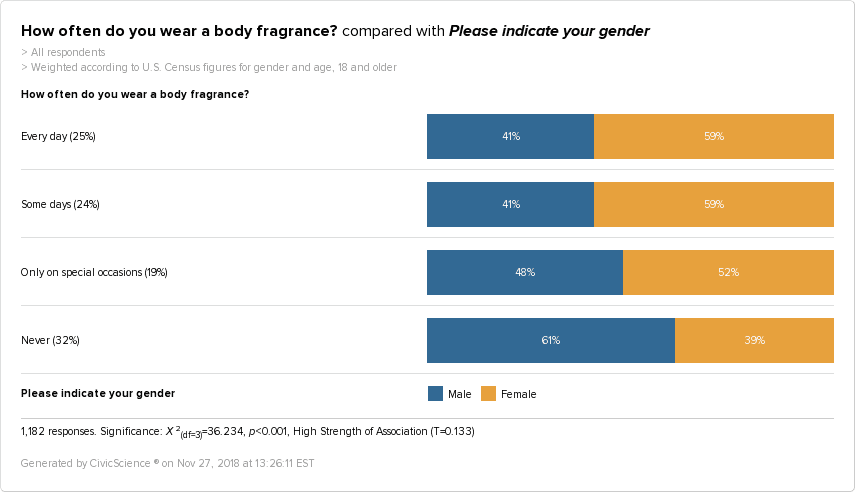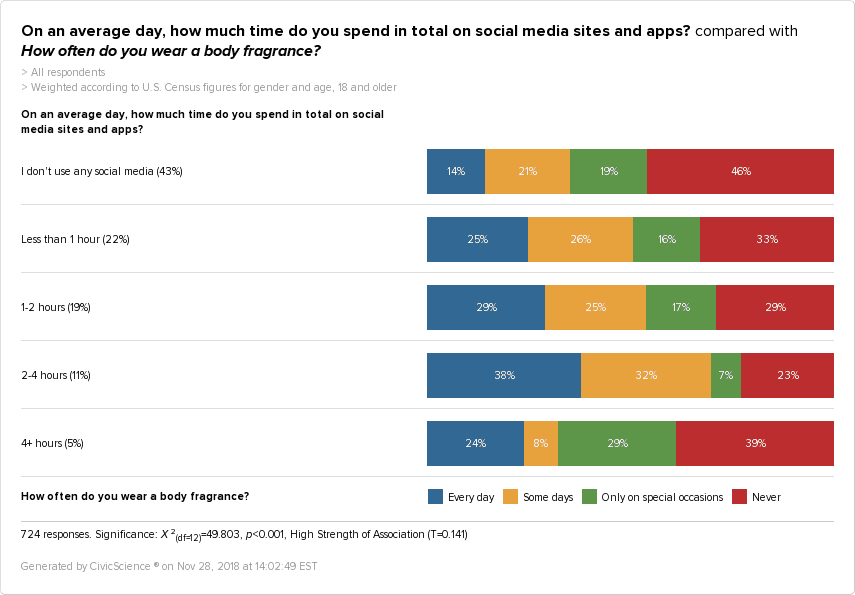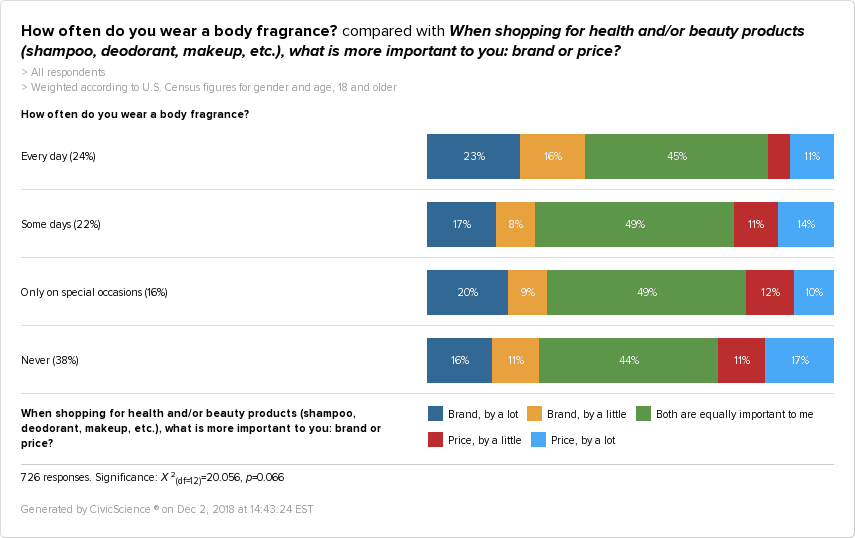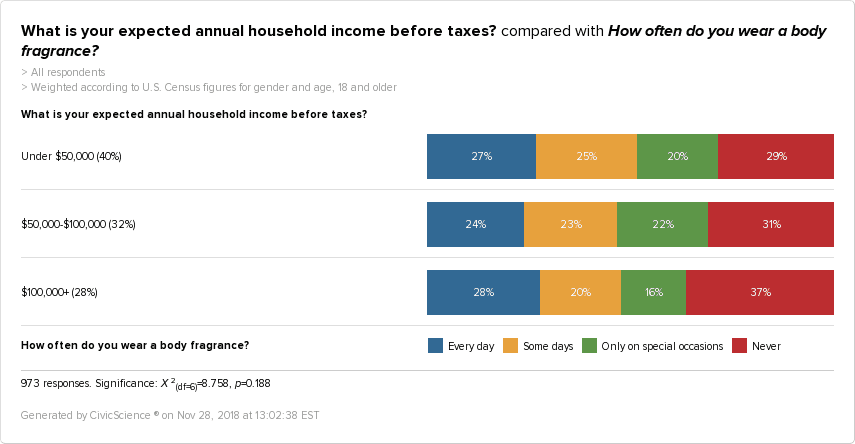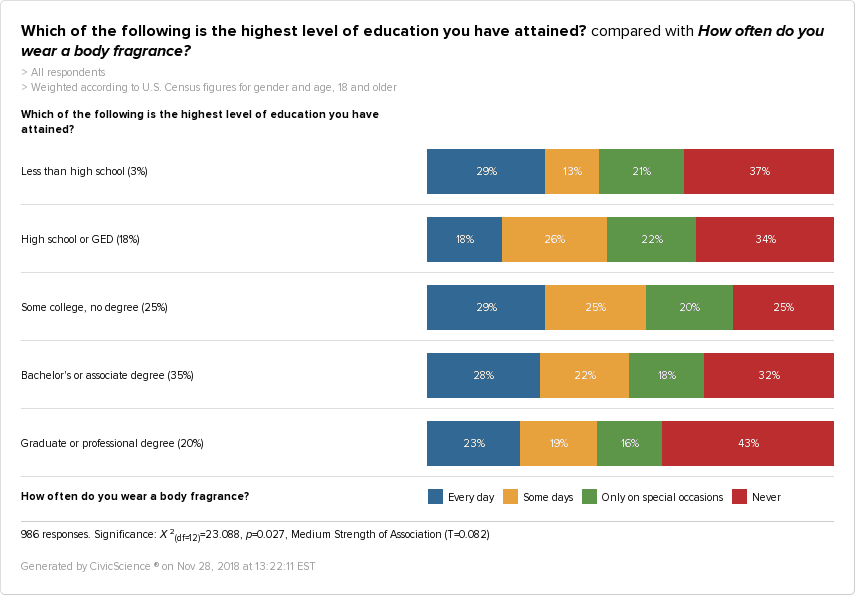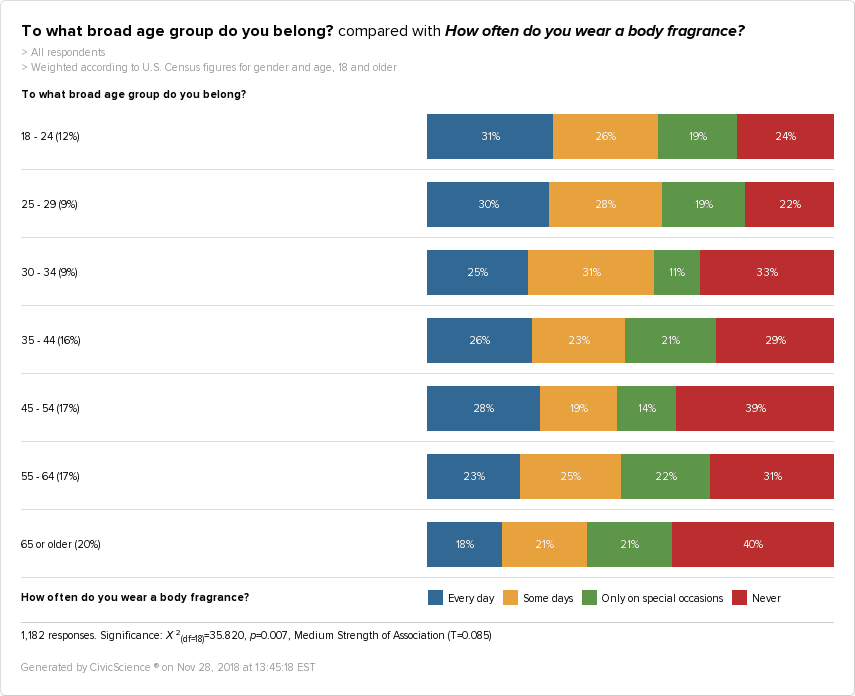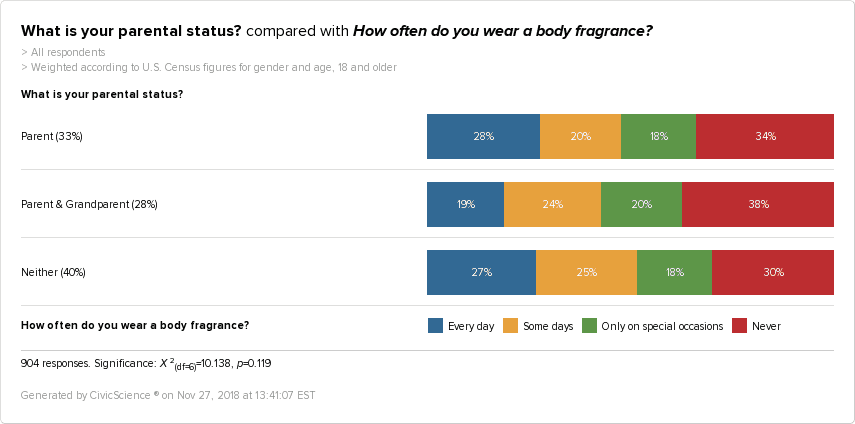Scents are big business. So big, in fact, that some estimates believe the global fragrance market will reach $70 billion by 2022. With so much money pouring into the art of smelling good, CivicScience asked 1,181 U.S. adults about their experience with fragrances.
According to the data, a quarter of the population wears a fragrance every day. This number on its own is considerable, but, when combined with those who wear fragrances some days and only on special occasions, a large majority–68% of U.S. adults, to be exact–wear a fragrance at some point in their life.
An anomaly in the beauty world, fragrances are not just targeted towards women. Countless scented products–from cologne to deodorant–are also marketed towards men. And while women still dominate the respondents who are wearing fragrances, men are not lagging far behind, relatively speaking. Of those who do wear fragrances, men are most likely to wear them on special occasions. However, as 41% of people who wear fragrances every day are male, it’s a potential indicator of the loyal subset of men buying into the male fragrance niche.
All Eyes on Social Media
In terms of advertising, it is easy to see where fragrance companies can find their most frequent wearers. Those who wear fragrances most often spend an average of 2-4 hours a day on social media. Additionally, those who wear fragrances only on special occasions spend 4+ hours on social media sites. So, depending on the intended consumer, the fragrance industry would be wise to allocate social media marketing budgets accordingly.
Fragrance Brand is Key
When asked whether brand or price mattered most to consumers who shop for health and beauty products, the overwhelming answer was that both are equally important. However, of those who wear a fragrance every day, brand is also a prime factor.
The same goes for those who wear fragrances only on special occasions–brand outweighs price again. This suggests that consumers may be willing to purchase at a higher price point if it’s a brand they know they can trust. On many levels, this makes sense. Fragrances, especially those worn daily, become part of your routine and need to be reliable, day-in and day-out. For many, brand name may provide the reassurance that this is a product made to last.
Fragrances for All?
It seems that, when it comes to wearing a fragrance, income may also be a factor. While high-income earners are the most likely to wear a fragrance every day, low-income earners are not far behind. These groups are largely polarized between individuals who wear fragrances every day and those who do not wear fragrances at all.
Middle-income earners tend to be more evenly split in terms of their fragrance wearing frequency.
This particular question is intentionally open-ended enough to include fragrances in everything from body wash to high-end perfume. As a result, it seems that it is not necessarily fragrances that are income-specific, but perhaps the product in which they’re used. Are low-income earners wearing fragrances at a lower price point than their high-income counterparts? It is certainly something to consider. But, regardless of where U.S. adults are accessing fragrances, it is clear that income is not a barrier to smelling good.
Different Degrees of Interest
In many cases, income and level of education are linked. And, as the data reveals, the level of education does, in fact, play a role in choosing to wear a fragrance, and how often. Those with less than a high school degree and those with some college but no degree are tied for wearing fragrances every day. Those with a bachelor’s degree also frequently wear fragrances. However, daily fragrance-wearing takes a dip for those with graduate or professional degrees.
While some of these figures could be linked to the level of education an individual has regarding what exactly is in the fragrance they’re putting on their body, they might also be correlated with stage of life, as education and life stage often go hand-in-hand.
A Fragrant Stage of Life
In the graph below, the wave-like evolution of everyday fragrance wearing demonstrates how daily fragrance wearers peak in the 18-24 set, only to have a slight revival amongst those who are 45-54 years old.
Fragrances, by the nature of their scent, tend to make a statement. Is it possible that this sort of attention is more acceptable in youth? Are older daily fragrance wearers attempting to reclaim the vitality of years past? Statistically speaking, the mid-life crisis is real. Could fragrance be part of that middle-aged desire to cast a new outlook on life?
The fact that parents make up the largest group of those who report wearing a fragrance every day, followed closely by those who are neither parents nor grandparents, could support this notion.
In a stage of life where others’ needs tend to be a larger priority, wearing a daily fragrance could symbolize a certain level of agency, or an attempt to reclaim authority over some small aspect of daily self-care.
As the data shows, those who wear a fragrance every day tend to believe they are much more physically attractive. So there is a very real potential for interplay between the idea of self-care and the self-confidence that wearing a fragrance seems to imbue.
As for those who never wear a fragrance, they are more likely to believe they are much less physically attractive. And while there are countless factors that could be influencing each response, the potential connection between fragrance and self-evaluation is difficult to ignore.
Fragrance wearing is common amongst U.S. adults, and further inquiry reveals just how central it may be to making people feel good about themselves. Whether they’re embracing youth, seeking to reclaim a sense of independence or in search of a little more self-care, fragrances could be the solution.

